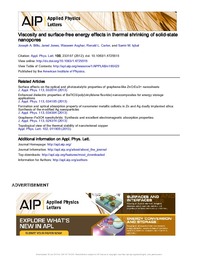
ATTENTION: The works hosted here are being migrated to a new repository that will consolidate resources, improve discoverability, and better show UTA's research impact on the global community. We will update authors as the migration progresses. Please see MavMatrix for more information.
Show simple item record
| dc.contributor.author | Iqbal, Samir M. | |
| dc.contributor.author | Asghar, Waseem | |
| dc.contributor.author | Billo, Joseph A. | |
| dc.contributor.author | Carter, Ronald L. | |
| dc.contributor.author | Jones, Jared | |
| dc.date.accessioned | 2013-01-18T20:40:14Z | |
| dc.date.available | 2013-01-18T20:40:14Z | |
| dc.date.issued | 2012-06-05 | |
| dc.identifier.citation | Applied Physics Letters, vol. 100, no. 23, pp. 233107 (2012) | en_US |
| dc.identifier.uri | http://hdl.handle.net/10106/11259 | |
| dc.description.abstract | Solid-state nanopores are fabricated by either drilling these in thin membranes or by shrinking large pores with electron/ion beam. Simple heating of thin membranes with many large pores has been shown recently to controllably shrink these to nanoscale in parallel. Thermal heating of solid membrane in furnace changes the physical material properties. A model for the experimental nanopore shrinking data is developed. The parametric variations of viscosity, movement of adatoms and diffusion coefficients at temperature points around 1000 °C are characterized. The model provides a framework to understand and predict thermal shrinking of nanopores. | en_US |
| dc.language.iso | en_US | en_US |
| dc.publisher | American Institute of Physics; | en_US |
| dc.subject | Nanofabrication | en_US |
| dc.subject | Nanoporous materials | en_US |
| dc.subject | Shrinkage | en_US |
| dc.subject | Thermal diffusion | en_US |
| dc.title | Viscosity and surface-free energy effects in thermal shrinking of solid-state nanopores | en_US |
| dc.type | Article | en_US |
| dc.publisher.department | Department of Electrical Engineering, University of Texas at Arlington | en |
| dc.identifier.externalLinkDescription | The original publication is available at Article DOI | en_US |
| dc.identifier.doi | http://dx.doi.org/10.1063/1.4725515 | |
Files in this item
- Name:
- ApplPhysLett_100_233107.pdf
- Size:
- 714.0Kb
- Format:
- PDF
- Description:
- PDF
This item appears in the following Collection(s)
Show simple item record


